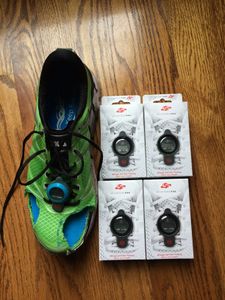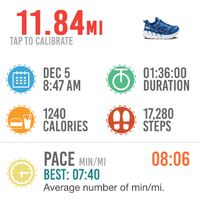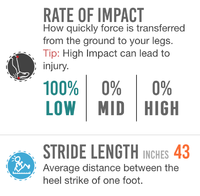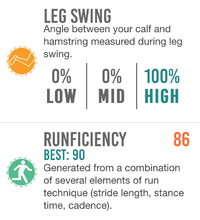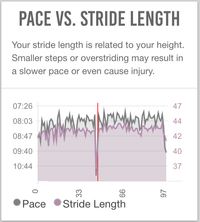MilestonePod
The MilestonePod is a simple way of tracking the mileage of your shoes, but it's also a Running Sensor that will gather data on your Running Form. I think the MilestonePod is well worth the price even if it only tracked overall mileage for your shoes. Given the extra data it records, it's a real bargain. Error: Could not parse data from Amazon!. (Version 3 of the Milestone pod has been released and I will be testing it shortly.)
- The MilestonePod has a small LCD display that shows the total miles recorded for that shoe.
- For each run it will record your distance, time, and number of steps. Like all Footpods, the MilestonePod requires calibration on each run.
- The MilestonePod records the percentage of time spent in Heel, Mid, and Forefoot Foot Strikes.
- Cadence is recorded as an average and best (maximum value) for each run. From the distance and the Cadence, stride length is calculated.
- Stance Time, which is more commonly called Ground Contact Time is how long your foot is on the ground rather than in the air. Again, the average and best (minimum) time is recorded for each run. The The Science of Running Economy indicates that longer Ground Contact Time costs more energy (reduced Running Economy.)
- The impact force of your foot landing is recorded as a percentage of time that is low, medium, or high. Unlike RunScribe, MilestonePod looks at how fast the impact builds up rather than just looking at the peak force. The Science of Running Shoes does not support the idea that higher impact results in higher injury rates, and there's some evidence to the contrary. However, impact can be measured in many different ways, making it harder to interpret.
- Leg swing is the angle between your upper and lower leg after toe off. A narrower angle, which is where the foot is closer to your hip with a more bent knee can reduce the effort needed to bring the trailing leg forward for the next stride.
- MilestonePod calculates a "runficiency" score, which is intended to reflect your overall efficiency.
- There are a few graphs that are available but these are rather small and tricky to interpret. They show "pace vs. cadence", "pace vs. stride length", "pace vs. stance time", "pace vs. runficiency", plus a graph of Foot Strike, Rate of Impact, and Leg Angle.
- Data can be exported as an excel spreadsheet with one row per run. This makes it far easier to analyze your data.
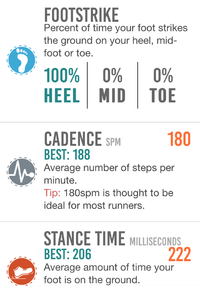 Foot Strike, Cadence and Stance Time (Ground Contact Time) |
1 Limitations
There are a number of limitations to the MilestonePod.
- There is no real time data available during your run, and you have to sync with a Smartphone when you're finished to see the data.
- The data is only available on your Smartphone, not their web site.
- Having data given as percentage of time in high/medium/low buckets rather than a score has pros and cons can be hard to interpret if all your time is in one bucket.
- The MilestonePod does not act as a Footpod for a Bluetooth watch like the Polar V800.
Some of these limitations could be resolved in future firmware updates, but I don't have any insight into this.
2 Testing Milestone Pod
I've tested a number of the metrics for the Milestone Pod, and I'll continue testing against other systems.
- Distance. Because Milestone is not a GPS device, I can't perform my statistical analysis that I do for GPS Accuracy. However, my informal testing suggests that Milestone can be quite accurate.
- The placement of the pod on the laces seems to be important. The pod should be placed over the arch of the foot, which is typically the second or third crossing of the laces (counting from near the toes.) This seems to give the pod a stable position, as wobbling our bouncing will cause problems.
- The pod requires calibration. If you place it badly and don't calibrate, the error can be as much as 25%, though if it's well placed I've typically seen errors of 6-8%.
- Radical changes of footstrike, from heelstrike to forefoot only can result in greater errors, though I've normally only seen this when I've also not placed the pod in the right place. (It took me a while to realize placement was important.)
- Milestone will work out when your run starts and stops, but you can confuse it if you take breaks in the middle of a run.
- With calibration and correct placement I see a typical error of 1-2%, which is better than most GPS systems.
- Cadence seems accurate when compared with other systems and verifying with a metronome. Note that walking breaks might impact your reading.
- Ground Contact Time is surprisingly accurate; I found it to be better than the far more expensive RunScribe. I validated this using High Speed Video.
- Footstrike is reasonably good, though it can get things wrong. This is partly because placement is important, and I've found better results when I've put the pod over the arch of my foot. Footstrike is an area where RunScribe does better, which is what you'd expect from a 9-axis system.
- Impact is not something I've been able to verify. I am working on correlating Milestone's Rate Of Impact (ROI) with RunScribe's Impact, and TgForce's Tibial Impact. These are three quite different types of metric, so it won't be a verification so much as looking for patterns. I've found that my ROI is all in the low category, making it a little trickier to find patterns.
- Leg Angle is not something I'm attempting to verify.
3 Compared with RunScribe
RunScribe is a much more expensive and more sophisticated device that has quite different capabilities. I highly recommend both devices, as they fulfill different purposes.
- The MilestonePod is an easy way to track the mileage of your shoes. This is something that is as easy with RunScribe, especially given that devices more limited battery life.
- MilestonePod does not provide the detailed metrics that is available from RunScribe. There is some overlap, such as Ground Contact Time, but MilestonePod only give summary data, not a detailed graph over time.
- While you could wear two MilestonePod, one on each foot, they are not designed to give comparison data to find biomechanical imbalances.
